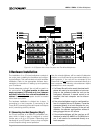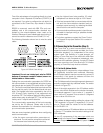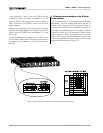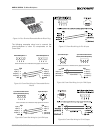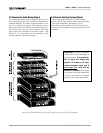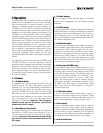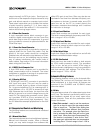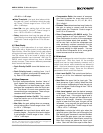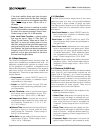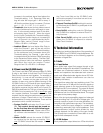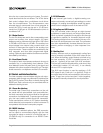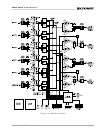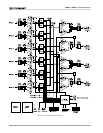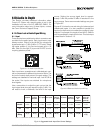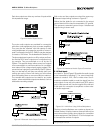
Page 18 IQ–AMB-5 / IQ–SMX-6
Reference Manual
AMB-5 / SMX-6 IQ Mixer/Multiplexer
If the level audibly drops each time the gate
opens, try a lower value for Idle Gain. Idle gain
should never be set to a value greater than Max
Gain. Control range is from –100 to +25 in
1
/2-
dB steps.
• Reaction Time: the time in seconds to adjust
gain 10 dB toward the necessary gain structure
to obtain the desired average output level.
Control range is from 0.2, to 30 seconds.
• Auto Level Gate Function: a global setting
that may be set to “Open To Idle Gain” or
“Open To Last Position.” When set to “Open To
Idle Gain” an input will initially gate on to the
Idle Gain setting and the auto level feature will
take over from that point. When set to “Open To
Last Position” the auto level feature remembers
the gain of the VCA at the time the input last
gated off so that gain goes back to that level
the next time the gate opens.
4.2.10 Output Compressor
The Output Compressor/Limiter function keeps the
output from exceeding a predetermined level. It's
especially valuable when used as an output limiter
for the protection of amplifiers, loudspeakers and
other audio equipment. Compression of the signal at
each input occurs only when the mix exceeds the
limit threshold. There are six parameters which con-
trol this feature:
• Compressor: a master ON/OFF switch for
each output that enables or disables output
compression for that output.
• Limiter:
an ON/OFF switch for each VCA that
configures which inputs may participate in out-
put compression.
••
••
• Limit Threshold: used to set the peak signal
level above which compression occurs. Con-
trol range is from –100 to +25 in
1
/2 dB steps.
••
••
• Compression Ratio: controls the amount of
compression that is applied for every step over
the Threshold. Choices are 1:1, 2:1, 4:1, 8:1,
16:1, 32:1, infinity:1.
••
••
• Release Time: determines how long it takes for
the gain to return to normal when the level
drops below the Threshold. Control range is
from 0.2 to 30 seconds.
••
••
• Max Gain: the gain setting of the input when no
compression is active. Control range is from –
100 to +25 in
1
/2-dB steps.
4.2.11 Gate Count
The Gate Count function keeps track of how many
gates are open at a time, and provides feedback
control when a large number of inputs are open.
The Gate function must be on for the Gate Count to
operate. There are four parameters which control
this feature:
Gate Count Master: a master ON/OFF switch for
each output that enables or disables gate
counting for that output.
Gate Count: an ON/OFF switch for each VCA
that configures which inputs may participate in
the gate count.
Gate Count Level: determines how much each
input is attenuated as more gates open. When
only one mic in a count group is active, there is
no added attenuation. Each additional open
mic increases the attenuation by the “Count
Level.” Control range is from 0.5 to 16 dB.
Max Gain: the gain setting that will be used when
the gate is “open,” and no further attenuation is
indicated. Control range is from –100 to +25 in
1
/2-dB steps.
4.2.12 Ambience (IQ–AMB-5 only)
The Ambience function monitors the ambient sense
input (Input 6) and automatically adjusts the mix
output level of Channel 1 up or down accordingly.
This enables the IQ–AMB-5 to automatically mix and
control the overall loudness in an environment with
background noise levels that vary. Functionally, the
ambience function operates after all other functions
have processed the audio signals. There are six
parameters which control this feature:
Ambience: an On/Off switch that enables of dis-
ables the Ambience feature
• Attack Time: determines how rapidly the Am-
bience function will begin to increase the out-
put level of Channel 1 above the Ambient offset
level once the level of Input 6 exceeds the
Threshold. Control range is from 0.2 to 30 sec-
onds.
• Decay Time: determines how rapidly the Am-
bience function will begin to reduce the output
level of Channel 1 while the ambient sense in-
put level is dropping. Control range is from 0.2
to 30 seconds.
• Expansion Ratio: determines how much the
gain of output Channel 1 will increase for every



